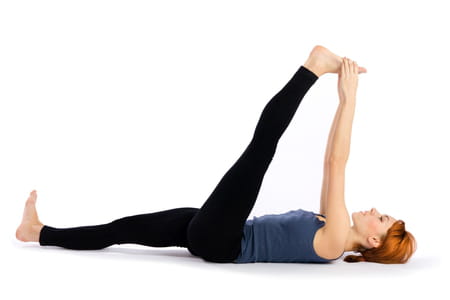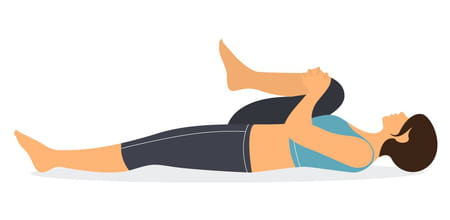Sciatica is characterized by pain in the lower limb located in the path of the sciatic nerve. This pain therefore often extends from the lower back to the foot. If you suffer from it, the practice of yoga, in addition to good medical monitoring, can be beneficial and prevent attacks.
Can you do yoga if you have sciatica?
“The yoga acts in a slow and deep way so it is excellent in prevention and reconstruction and many postures can prevent seizures sciatica“, explain Catherine and Nathalie Claudia, yoga teachers in Haute-Corse.
How many sessions per week?
Still preventively, yoga can be practiced three to five times a week. Regularity matters. “As soon as the crisis is over, you have to move because movement helps to recover. “To continue to relieve any discomfort, it is then possible to practice two to three gentle postures while listening to his feelings”. “Once the pain has passed, we can go back to a full session.”
Which yoga postures to relieve sciatica?
To prevent sciatica attacks and restructure, it is possible to practice the following postures: Adho Mukha Svanasana (dog upside down), Virabhadrasana 2 (warrior stance 2), Utthita Parvottanasana (side angle posture), Salabhasana (grasshopper posture), Jathara Parivartanasana (posture of belly in twist), Supta Padangusthasana, Supta Pavana Muktasana (Wind Release Pose). To relieve the crisis of sciatica, the two professors recommend these three postures:
► Supta padangusthasana
Posture: Lie flat on the floor with your back ;
- Stretch the left leg on the ground, toes towards the head, and raise the kneecap.
- Turn the thigh inward;
- Bend the right leg towards the chest,
- Pass a belt above the heel (this particularly helps to put the lower back flat on the ground) and extend the right leg towards the sky, kneecap raised. If the flexibility of the back of the leg does not allow you to reach 90°, then go up less high but straighten your leg;
- Check that the two iliac spines are aligned, so that the lower back stretches correctly;
- Spread your elbows to be able to breathe more fully;
- Pull the belt towards the floor, from the shoulders, and simultaneously push the heel towards the ceiling; imagine you want to bring in theischium of your leg raised in the ground, while wanting to touch the ceiling your heel;
- Bring the chin towards the sternum.
Posture outfit:
- Stay in the pose for 30 seconds (1 minute for non-beginners), then bend your leg towards you on an exhale;
- Switch sides.
► Supta padangusthasana with neuro dynamic movement
This allows the nerve to slide and thus relieve. For it :
- Lie on your back with one leg bent over your stomach with your foot flexed;
- Unfold the leg slowly, pointing the foot towards the sky without necessarily stretching it completely, then fold the leg with the bent foot;
- Chain the movement 5 to 8 times then change legs.
► Supta Pavanamuktasana or posture of the release of the winds
Posture taking
- Lie on your back with your legs and feet together, arms and hands beside your body, palms down;
- Keep the left leg stretched out on the ground, toes towards you, kneecap raised, thigh facing inward;
- Inhale deeply, exhale and bend the right knee;
- Bring the thigh towards the chest;
- Interlace your fingers and clasp the hands on the tibia just below the right knee.
- Stance Outfit
- Keep the left leg straight on the ground, pointing the heel towards the opposite wall (and not the toes);
- Make sure that the right buttocks remain in good contact with the ground;
- Breathe calmly through your stomach.
- Stance exit
- Exhaling slowly, extend your bent leg on the floor;
- Change legs then redo the posture by bringing both legs towards you, knees bent, lower back on floor;
- Breathe deeply, stay aware of your breath;
- Relax the lower back towards the ground, also relax the stomach, relax the shoulders, the neck, the throat and the back of the head.
What precautions should be taken during a yoga session?
“In yoga it is important to understand how to take, hold and come out of the posture. Learn the poses under the supervision of a certified teacher is important to be able to practice safely“, advise Nathalie and Catherine Claudia.
What are the contraindications in case of sciatica?
“In the midst of sciatica the postures will be much too strong and the movements impossible to achieve. It is only once the crisis has passed that we will practice a few gentle postures and then return to a full session. Remember to breathe deeply because breathing is a natural painkiller and drink plenty of water.”
thanks to Catherine and Nathalie Claudiayoga teachers in Haute-Corse.
We would love to say thanks to the writer of this write-up for this incredible material
Yoga and sciatica: postures, contraindications
Take a look at our social media profiles and other related pageshttps://nimblespirit.com/related-pages/


